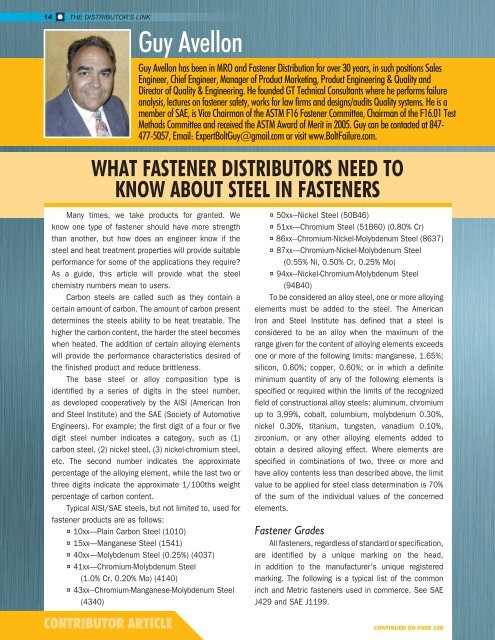SUMMER 2019
Distributor's Link Magazine Summer 2019 / Vol 42 No3
Distributor's Link Magazine Summer 2019 / Vol 42 No3
You also want an ePaper? Increase the reach of your titles
YUMPU automatically turns print PDFs into web optimized ePapers that Google loves.
14<br />
THE DISTRIBUTOR’S LINK<br />
Guy Avellon<br />
Guy Avellon has been in MRO and Fastener Distribution for over 30 years, in such positions Sales<br />
Engineer, Chief Engineer, Manager of Product Marketing, Product Engineering & Quality and<br />
Director of Quality & Engineering. He founded GT Technical Consultants where he performs failure<br />
analysis, lectures on fastener safety, works for law firms and designs/audits Quality systems. He is a<br />
member of SAE, is Vice Chairman of the ASTM F16 Fastener Committee, Chairman of the F16.01 Test<br />
Methods Committee and received the ASTM Award of Merit in 2005. Guy can be contacted at 847-<br />
477-5057, Email: ExpertBoltGuy@gmail.com or visit www.BoltFailure.com.<br />
WHAT FASTENER DISTRIBUTORS NEED TO<br />
KNOW ABOUT STEEL IN FASTENERS<br />
Many times, we take products for granted. We<br />
know one type of fastener should have more strength<br />
than another, but how does an engineer know if the<br />
steel and heat treatment properties will provide suitable<br />
performance for some of the applications they require?<br />
As a guide, this article will provide what the steel<br />
chemistry numbers mean to users.<br />
Carbon steels are called such as they contain a<br />
certain amount of carbon. The amount of carbon present<br />
determines the steels ability to be heat treatable. The<br />
higher the carbon content, the harder the steel becomes<br />
when heated. The addition of certain alloying elements<br />
will provide the performance characteristics desired of<br />
the finished product and reduce brittleness.<br />
The base steel or alloy composition type is<br />
identified by a series of digits in the steel number,<br />
as developed cooperatively by the AISI (American Iron<br />
and Steel Institute) and the SAE (Society of Automotive<br />
Engineers). For example; the first digit of a four or five<br />
digit steel number indicates a category, such as (1)<br />
carbon steel, (2) nickel steel, (3) nickel-chromium steel,<br />
etc. The second number indicates the approximate<br />
percentage of the alloying element, while the last two or<br />
three digits indicate the approximate 1/100ths weight<br />
percentage of carbon content.<br />
Typical AISI/SAE steels, but not limited to, used for<br />
fastener products are as follows:<br />
¤ 10xx—Plain Carbon Steel (1010)<br />
¤ 15xx—Manganese Steel (1541)<br />
¤ 40xx—Molybdenum Steel (0.25%) (4037)<br />
¤ 41xx—Chromium-Molybdenum Steel<br />
(1.0% Cr, 0.20% Mo) (4140)<br />
¤ 43xx---Chromium-Manganese-Molybdenum Steel<br />
(4340)<br />
CONTRIBUTOR ARTICLE<br />
¤ 50xx---Nickel Steel (50B46)<br />
¤ 51xx—Chromium Steel (51B60) (0.80% Cr)<br />
¤ 86xx---Chromium-Nickel-Molybdenum Steel (8637)<br />
¤ 87xx—Chromium-Nickel-Molybdenum Steel<br />
(0.55% Ni, 0.50% Cr, 0.25% Mo)<br />
¤ 94xx---Nickel-Chromium-Molybdenum Steel<br />
(94B40)<br />
To be considered an alloy steel, one or more alloying<br />
elements must be added to the steel. The American<br />
Iron and Steel Institute has defined that a steel is<br />
considered to be an alloy when the maximum of the<br />
range given for the content of alloying elements exceeds<br />
one or more of the following limits: manganese, 1.65%;<br />
silicon, 0.60%; copper, 0.60%; or in which a definite<br />
minimum quantity of any of the following elements is<br />
specified or required within the limits of the recognized<br />
field of constructional alloy steels: aluminum, chromium<br />
up to 3.99%, cobalt, columbium, molybdenum 0.30%,<br />
nickel 0.30%, titanium, tungsten, vanadium 0.10%,<br />
zirconium, or any other alloying elements added to<br />
obtain a desired alloying effect. Where elements are<br />
specified in combinations of two, three or more and<br />
have alloy contents less than described above, the limit<br />
value to be applied for steel class determination is 70%<br />
of the sum of the individual values of the concerned<br />
elements.<br />
Fastener Grades<br />
All fasteners, regardless of standard or specification,<br />
are identified by a unique marking on the head,<br />
in addition to the manufacturer’s unique registered<br />
marking. The following is a typical list of the common<br />
inch and Metric fasteners used in commerce. See SAE<br />
J429 and SAE J1199.<br />
CONTINUED ON PAGE 128

















